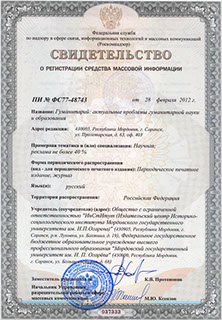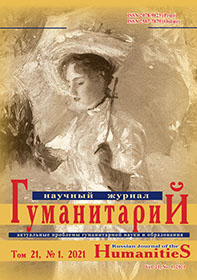ГуманитариЙ актуальные проблемы гуманитарной науки и образования
Russian Journal of the Humanities
ISSN 2078-9823 (Print)
ISSN 2587-7879 (Online)
Navigation
ISSN 2078-9823 (Print), ISSN 2587-7879 (Online)
DOI: 10.15507/2078-9823.053.021.202101.063-077
УДК 1/14.172
Ekaterina A. Koval1 , Andrey A. Sychеv2, Natalya V. Zhadunova3
1 Middle-Volga Institute (Branch) of All-Russian State University of Justice (Saransk, Russia),
e-mail: nwifesc@yandex.ru
2 National Research Mordovia State University (Saransk, Russia),
e-mail: sychevaa@mail.ru
3 National Research Mordovia State University (Saransk, Russia),
e-mail: zhadunovan@mail.ru
Revolutions in Norm-Creating: Law, Morality, Religion
Introduction. The emergence of social norms is usually described as a spontaneous, objectively conditioned process. However, the norm-creating approach to the study of the indicated problem allows obtaining a fundamentally new optics of socio-philosophical studies of normativity. The purpose of this article is to analyze the position of various normative regulators (law, morality, religion) in the value-normative hierarchy, conditioned by the rule-making activity of individual and collective subjects. Materials and Methods. The theoretical and methodological basis of the study is a systematic approach that allows considering law, morality and religion as elements of a single value-normative space. To conceptualize norm-making revolutions, the model of the social imaginary in the interpretation of C. Castoriadis and Ch. Taylor is used. Results. Three norm-creating revolutions are described: moral, religious and legal, each of which is characterized by the priority of the corresponding normative regulator. The moral stage was preceded by the stage of the emergence of social norms and the primary social imaginary, characterized by the priority of the group. The moral revolution was marked by the internalization of external norms into individual consciousness and the isolation of moral norms from other social normative regulators (that had not been differentiated in the syncretic consciousness of an archaic person). A religious revolution is characterized by other subjects of rule-making (God, Councils, bishops, etc.), the switch in the value hierarchy from an individual to a group, the formation of a new type of social imaginary. A legal revolution, which entailed a certain degree of legalization of morality and religion, is associated with the development of the ideas of human rights, justice, equality in the social imaginary. It is characterized by the priority of the individual interests and the expansion of the circle of subjects of norm-creating, although their degree of participation in norm-making activities can be significantly differentiated. Discussion and Conclusion. Probably, the next norm-creating revolution has already begun, but it is not yet possible to fully understand its specifics. Most likely, the group again will occupy the center of the social imaginary, pushing the individual to the periphery of the value-normative space.
Keywords: norm creation, norm-creating revolution, social imaginary, syncretism, morality, religion, law, individual, group.
Acknowledgment: The research was carried out with the support of the Russian Foundation for Basic Research (grant No. 19-011-00082).
For citation: Koval E. A., Sychеv A. A., Zhadunova N. V. Revolutions in norm-creating: law, morality, religion. Gumanitarian : aktual’nye problemy gumanitarnoi nauki i obrazovaniia = Russian Journal of the Humanities. 2021; 21(1): 63–77 (In Russ.). DOI: 10.15507/2078-9823.053.021.202101.063-077.

© Ogarev Mordovia State University. History and Sociology Institute, 2017
68, Of. 411, Bolshevistskaya St., 430005, The editorial office of the scholarly journal «Russian Journal of the Humanities»
Tel.: (8342) 24-25-90; 27-07-11, Fax: (8342) 24-25-90, E-mail: jurnal-econom-hist@isi.mrsu.ru
Designed by A. Napalkov, Email: napalkov@isi.mrsu.ru

